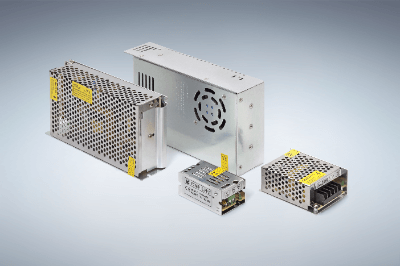What Is a Switching Power Supply?
 A switching power supply is a device that supplies DC power using a switching regulation method among DC power supplies.
A switching power supply is a device that supplies DC power using a switching regulation method among DC power supplies.
General power supplies can be roughly classified into two types: the linear type, which is low-cost but heavy due to its simple circuit structure, and the switching type, which is compact due to the use of ICs. Due to their respective characteristics, the linear type is used for simple AC adapters, while the switching type is used for supplying power to electronic components in facilities.
Uses of Switching Power Supplies
Switching power supplies are used to supply power to industrial information equipment. In recent years, as electronic equipment has become more sophisticated, AC adapters have shifted from heavy linear systems to compact switching systems.
Furthermore, with the spread of USB power supplies, switching power supplies has become an indispensable component for supplying power to compact electronic equipment. In the industrial field, switching power supplies are widely used as components that stably supply DC power to drive control electronic components such as solenoid valves and sensors in automated equipment.
Principle of Switching Power Supplies
A switching power supply is a device that uses an AC power source such as 100 VAC as input, converts it to a DC power source such as 5 to 30 VDC, and stably supplies it.
The circuit configuration of a typical switching power supply is as follows:
- Input Rectification and Rectifying Circuit
The input AC power supply is smoothed as much as possible. - Switching Circuit
Switching from AC power to DC power is possible. - Output Rectification and Rectifying Circuit
Smoothes the distorted DC power supply after conversion. - Control Circuit
Controls output voltage and output power.
This configuration makes it possible to obtain a stable DC power supply with constant voltage.
Other Information on a Switching Power Supply
1. Difference Between a Rectifier and a Power Supply
Rectifier is a generic term for an element that has the property of conducting current in one direction, while power supply is a generic term for a power source. A rectifier can be said to be an element that converts an AC power source into a DC power source. It is a diode or switching device that allows the current to flow in one direction.
There are two types of rectification: half-wave rectification and full-wave rectification.
Half-Wave Rectification
In AC circuits, positive and negative currents flow alternately, and “half-wave rectification” removes either the positive or negative current. The circuit configuration is simple and low-cost, but the efficiency is low and it cannot handle large currents.
Full-Wave Rectification
Full-wave rectification is a method that takes both positive and negative currents and changes them to a unidirectional current. This method is mainly used in switching power supplies. Compared to half-wave rectification, full-wave rectification is more efficient, and pulsation can be suppressed to a smaller degree.
Full-wave rectification includes a method that uses two diodes and a bridge circuit method that combines four diodes. Since the current after these rectifications is unstable, the output from the rectifier is combined with a circuit, such as a capacitor, for smoothing to remove pulsation and function as a power supply.
2. Causes of Failure of Switching Power Supply
There are “external factors” and “internal factors” that cause failures in switching power supplies.
Failure Due to External Factors
- Physical destruction
- Sudden influx of high voltage or noise due to lightning
- Circuit short-circuit failure due to dust or moisture intrusion
- Destruction of various parts of the circuit due to chemicals or corrosive gases
In particular, the sudden application of high voltage due to lightning strikes destroys each element and other electronic components inside the power supply. To prevent these failures, it is effective to install protective circuit products such as surge killers.
Failures Due to Internal Factors
Internal factors are caused by the deterioration or failure of electrolytic capacitors, cooling fans, semiconductor components, etc. The usable life of a power supply varies greatly depending on the environment in which it is used, the time it is used, and other factors.